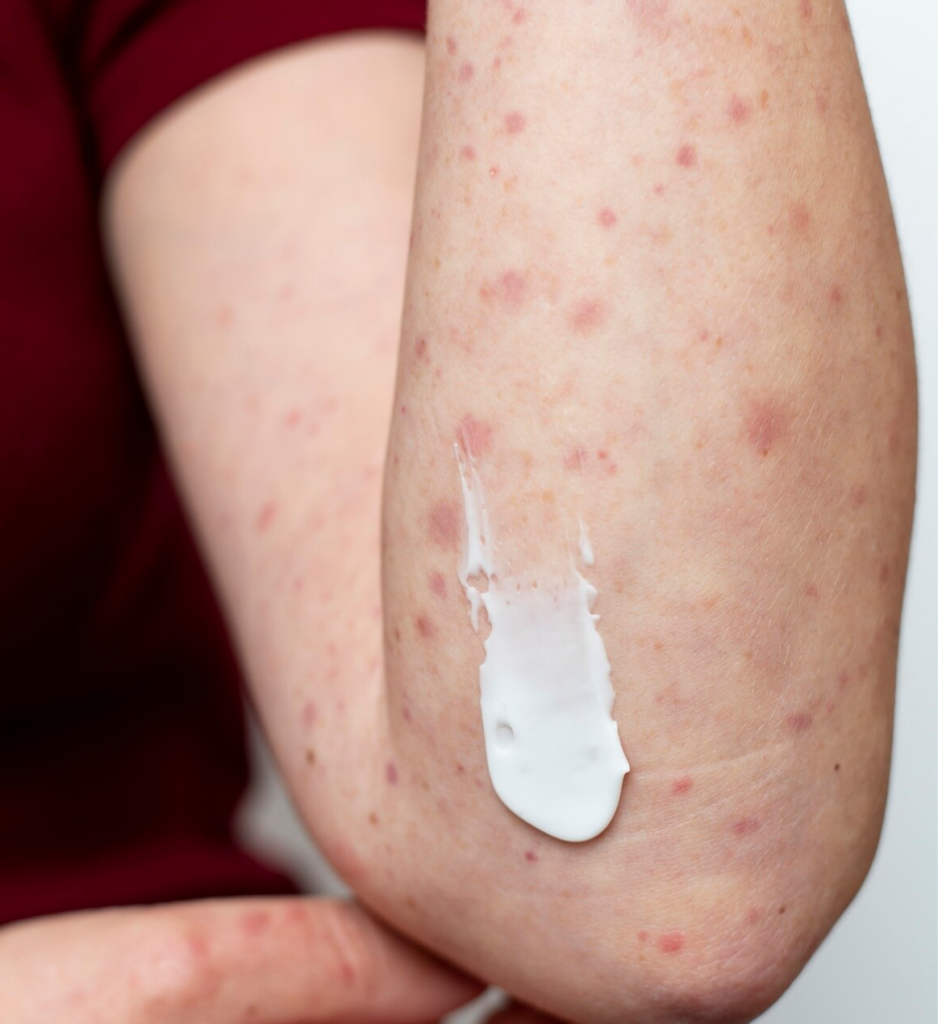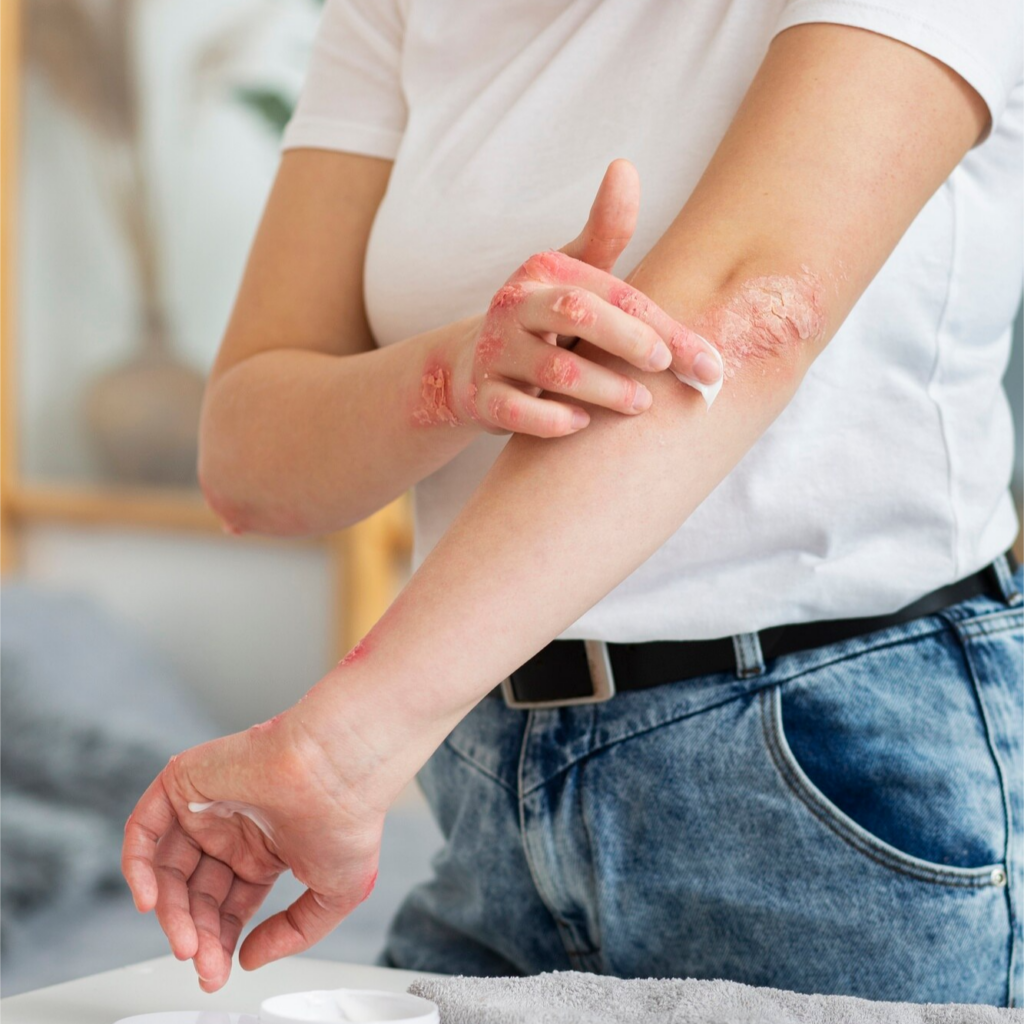Keratosis pilaris (KP), often referred to as “chicken skin,” is a common skin condition that affects a large portion of the population, causing small, rough, and often red or white bumps to form on the skin, typically on the arms, thighs, face, and back.

Though harmless, the condition can be bothersome and lead to self-consciousness due to its appearance. While there are various treatments available, one of the most frequently recommended solutions is salicylic acid.
Understanding Keratosis Pilaris
Keratosis pilaris occurs when hair follicles become clogged with keratin, a protein that protects the skin. This buildup leads to the formation of small, hard bumps on the skin’s surface.
Though KP is not harmful, it can create an uneven texture and, in some cases, cause itching or redness. The condition is most common in individuals with dry skin or a family history of the condition, and it often appears during childhood or adolescence.
While KP typically resolves with age, many individuals seek ways to minimize or treat its appearance. This is where topical treatments like salicylic acid come into play.
What Is Salicylic Acid?
Salicylic acid is a beta-hydroxy acid (BHA) that is commonly used in skincare products. It is derived from willow bark and is well-known for its exfoliating properties.
As a chemical exfoliant, salicylic acid works by penetrating the skin and dissolving the bonds between dead skin cells, allowing them to be removed from the surface of the skin.
In doing so, it helps to clear clogged pores and smooth the skin’s texture. Salicylic acid is most commonly found in acne treatments because of its ability to treat blemishes and prevent breakouts, but its benefits extend beyond acne.
In addition to exfoliation, salicylic acid also has anti-inflammatory properties, making it useful in treating conditions like psoriasis and eczema. This makes salicylic acid a potential ally in managing keratosis pilaris.
Salicylic Acid for Keratosis Pilaris: How Does It Work?
Salicylic acid is often recommended for the treatment of keratosis pilaris due to its unique ability to exfoliate the skin deeply and remove the buildup of keratin.
When applied to the affected areas, salicylic acid can break down the dead skin cells that clog the hair follicles, which is the root cause of KP. By loosening and shedding these skin cells, the acid helps to clear the bumps and smooth the skin’s surface.
Additionally, salicylic acid helps to reduce inflammation, which can be particularly beneficial in alleviating the redness or irritation associated with KP.
The anti-inflammatory action calms the skin, making it less likely to flare up and appear angry or inflamed. Over time, regular use of salicylic acid can promote a more even skin texture, reducing the prominence of the bumps and improving the overall appearance of the skin.
Benefits of Salicylic Acid for KP
Exfoliation
Exfoliation is the primary way that salicylic acid helps with keratosis pilaris. As an exfoliant, it works by breaking down the buildup of dead skin cells, which are responsible for blocking the hair follicles and causing the characteristic bumps.
Improvement of Skin Texture
Keratosis pilaris can leave the skin feeling rough and uneven. By regularly exfoliating with salicylic acid, you can soften the skin and achieve a smoother texture.
The exfoliating properties of salicylic acid gradually refine the skin’s surface, reducing the appearance of the bumps and leaving the skin feeling softer.
Reduction of Redness and Inflammation
Salicylic acid’s anti-inflammatory properties are essential for managing KP. Many individuals with keratosis pilaris experience redness or irritation around the bumps.
By reducing this inflammation, salicylic acid can help calm the skin and reduce the severity of flare-ups. This not only improves the appearance of the skin but also helps to make the condition less noticeable.
Prevention of Clogged Hair Follicles
One of the main causes of keratosis pilaris is the clogging of hair follicles with keratin. Salicylic acid works by penetrating the skin and dissolving the debris that clogs the follicles.
By regularly using salicylic acid, you can prevent the buildup of keratin, thus preventing new bumps from forming.

How to Use Salicylic Acid for Keratosis Pilaris
When incorporating salicylic acid into your skincare routine to treat keratosis pilaris, it is important to follow proper guidelines to ensure effectiveness and avoid irritation.
Choose the Right Product
Salicylic acid is available in various forms, including lotions, creams, gels, and cleansers. When treating KP, look for products with a salicylic acid concentration between 0.5% and 2%. d.
Patch Test First
Before applying salicylic acid to larger areas of your skin, it’s a good idea to perform a patch test. Apply a small amount of the product to a discreet area, such as your inner arm, and wait for 24 hours to check for any signs of irritation or allergic reaction.
Application and Frequency
Apply the salicylic acid product directly to the affected areas once or twice a day, depending on the strength of the product and your skin’s tolerance.
Moisturize and Protect
Salicylic acid can be drying, so it’s essential to follow up with a good moisturizer to keep the skin hydrated. Look for non-comedogenic moisturizers that won’t clog pores.
Potential Side Effects of Salicylic Acid
While salicylic acid is generally safe for most people, it’s important to be aware of potential side effects. Overuse or applying too strong a concentration of salicylic acid can lead to skin irritation, dryness, or peeling.
If you experience significant irritation, it’s best to reduce the frequency of application or switch to a product with a lower concentration. In rare cases, individuals with sensitive skin or allergies may develop a rash or hives.
Other Treatments for Keratosis Pilaris
While salicylic acid is effective for many individuals with keratosis pilaris, it may not be the only treatment needed. Other options include:
- Alpha Hydroxy Acids (AHAs): Like lactic acid, AHAs can also help exfoliate the skin and improve texture.
- Retinoids: Prescription-strength retinoids can help accelerate cell turnover and prevent clogged hair follicles.
- Moisturizing Treatments: Regular moisturizing with rich emollients can help soften the skin and reduce the rough texture caused by KP.
Conclusion
Salicylic acid can be an effective treatment for keratosis pilaris. Its exfoliating and anti-inflammatory properties work together to smooth the skin’s texture, reduce the appearance of bumps, and prevent new ones from forming.
However, as with any skincare treatment, it’s important to use salicylic acid properly to avoid irritation. Consistent, gentle use of the product, combined with proper moisturizing and sun protection, can yield noticeable improvements over time.
If salicylic acid alone doesn’t provide the desired results, consider consulting a dermatologist to explore additional treatments for keratosis pilaris.
By incorporating salicylic acid into your skincare routine, you may find that your keratosis pilaris becomes more manageable, allowing you to enjoy smoother, healthier-looking skin.